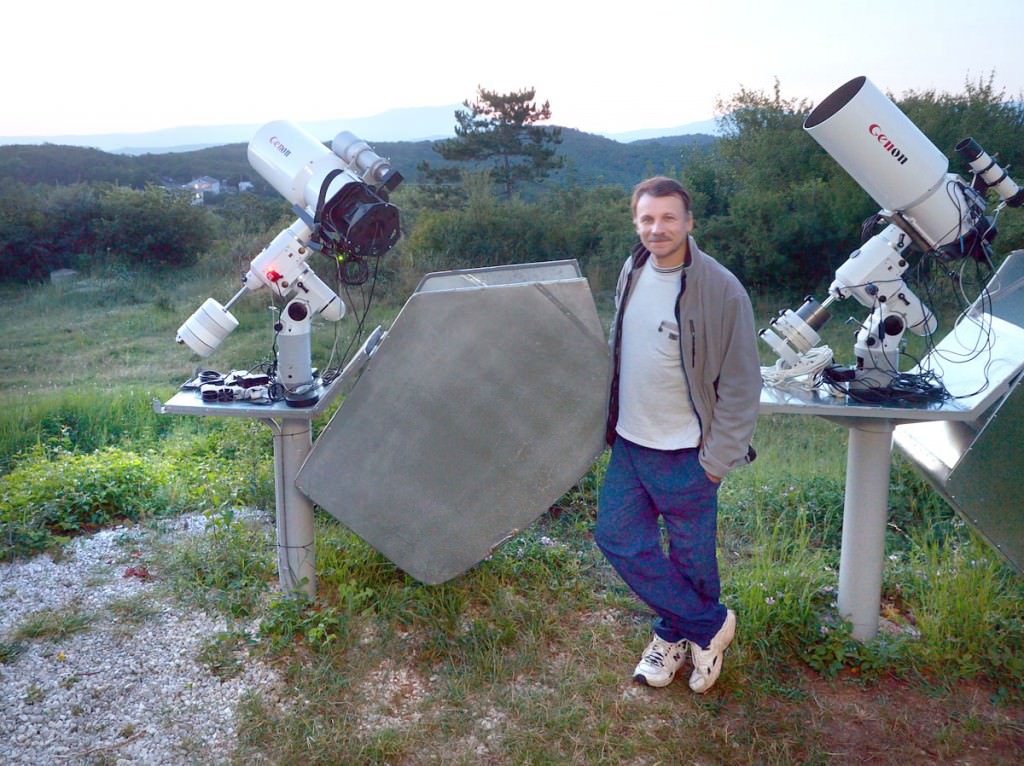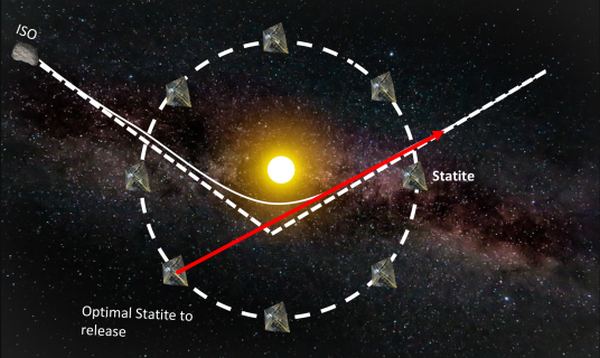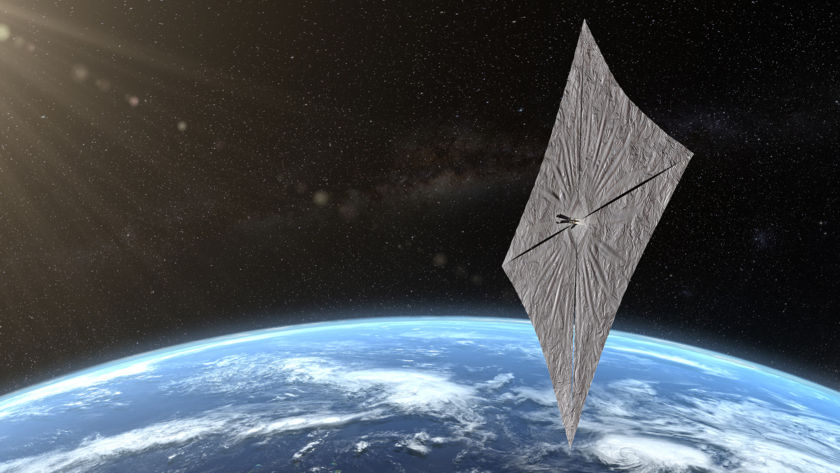Poor, dim-witted humanity.
We used to think we were the center of everything. That wasn’t that long ago, and even though we’ve made tremendous advancements in our understanding of our situation here in space, we still have huge blind spots.
For one, we’re only now waking up to the reality of interstellar objects passing through our Solar System.
In 2017, Oumuamua came for a brief visit, and was confirmed as an interstellar object. It’ll never return, and will spend an eternity travelling through the Universe.
Then a few months ago, we detected our first interstellar comet. An amateur astronomer—and telescope engineer—at a star party discovered it, and it was named after him. His name was Gennadiy Borisov, and it’s now called Comet 2L/Borisov. Pretty cool. Gennady Borisov, who lives in Naunchniy near the Crimean Observatory in the Ukraine, discovered the comet C/2013 N4 on July 8. He’s shown here with his two telescopes. Credit: Oleg Bruzgalov
Gennady Borisov, who lives in Naunchniy near the Crimean Observatory in the Ukraine, discovered the comet C/2013 N4 on July 8. He’s shown here with his two telescopes. Credit: Oleg Bruzgalov
But these objects are difficult to study. They show up and leave quickly. Comet Borisov in particular was travelling very quickly, at 32.2 km/s (20 mp/s) relative to the Sun, when inbound to our Solar System.
So how about sending a spacecraft to visit one of these interstellar visitors?
“We’d have to get there fast, and current propulsion technologies are a limiting factor.”Richard Linares, Ass’t Professor, Department of Aeronautics and Astronautics (AeroAstro) at MIT
That’s something that Richard Linares, an assistant professor in the Department of Aeronautics and Astronautics (AeroAstro) at MIT, has been thinking about. He’s got an idea.
He’s developing an idea for a “dynamic orbital slingshot for rendezvous with interstellar objects.” Now NASA’s getting involved. The NASA Innovative Advanced Concepts (NIAC) Program provides funding for “innovative aerospace concepts that could enable and transform future missions.” Now NIAC has selected Linares’ research proposal for Phase One funding.
NIAC is a well-known entity in space-science circles. They’ve funded studies into things like deep space probes powered by lightweight nuclear propulsion, sample-return systems for extreme environments, a Pluto Orbiter and Lander powered by Direct Fusion Drive, and dozens of others.
In a press release from MIT, Linares said “There are a lot of fundamental challenges with observing ISOs <Interstellar Objects> from Earth — they are usually so small that light from the sun needs to illuminate it in a certain way for our telescopes to even detect it.”
Not only is light a problem, so is the objects’ speed.
“And they are traveling so fast that it’s hard to pull together and launch a mission from Earth in the small window of opportunity we have before it’s gone,” Linares continued. “We’d have to get there fast, and current propulsion technologies are a limiting factor.”
So what’s his dynamic orbital slingshot, and how would it work?
“For the first time, we could obtain sensitive measurements of the bulk composition of other solar systems.”Benjamin Weiss, MIT Department of Earth, Atmospheric and Planetary Sciences
The idea is centered around solar sails. Solar sails are a propulsion based on stellar pressure, or the pressure of photons from the Sun. By using a thin, light, reflective material to catch those protons, much like a sailboat’s sail catches the wind, spacecraft can be propelled through space. Look at The Planetary Society’s LightSail 2 spacecraft for an example.
Solar Sails have their limitations. They’re effective with very light spacecraft. But a lightweight spacecraft is all a part of Linares’ concept.
Linares’ concept would see a fleet of static satellites on the edges of our Solar System. They would have a very low mass-to-sail-area ratio. Even at the edges of our Solar System, there’s enough sunlight to propel a solar sail spacecraft, so long as the sail is large enough and the mass of the spacecraft is small enough.
This fleet of sentinels would maintain their positions until we detected an incoming ISO. Linares calls them statites, and since they’re stationary, their initial status has zero velocity. That’s part of the trick, and according to a press release, “Once released, the stored energy in the solar sail would leverage the gravitational pull of the sun to slingshot the statite in a freefall trajectory towards the ISO, allowing it to catch up.”
If things went well, the spacecraft could then dispatch a nano-satellite to orbit the ISO, and train its sensors on it. There’d be no need for the main spacecraft to slow down, which would complicate the mission enormously.
“Flyby missions tend to be easier because they don’t require you to slow down — you fly past the object and try to get as many pictures as you can in that window,” says Linares. “A rendezvous mission is harder because you have to slow down and match the speed of the object so you can stay with it for a while. But the longer you can stay around the interstellar object, the better pool of data you can collect. Good science happens up close.” To ensure the best coverage of our solar system, MIT Assistant Professor Richard Linares envisions a constellation of “statites” that communicate and work together, only activating the statite in the optimum position to fly by or rendezvous with an interstellar object successfully. Other statites in the constellation can continue to wait for the next ISO to appear. Image Credit: Richard Linares, MIT.
To ensure the best coverage of our solar system, MIT Assistant Professor Richard Linares envisions a constellation of “statites” that communicate and work together, only activating the statite in the optimum position to fly by or rendezvous with an interstellar object successfully. Other statites in the constellation can continue to wait for the next ISO to appear. Image Credit: Richard Linares, MIT.
Linares is not the only behind this concept. There are three other researcheers involved, including Damon Landau at JPL. The team is taking a nine month period to work on their concept. They need to understand if it’s actually feasible or not, and they need to flesh out their concept.
Whether or not this concept could bear fruit, there’s no question about the scientific value of studying and ISO up close.
“Studying an interstellar body close-up would revolutionize our understanding of planet formation and evolution,” said team-member Benjamin Weiss, from the Department of Earth, Atmospheric and Planetary Sciences at MIT. “For the first time, we could obtain sensitive measurements of the bulk composition of other solar systems. We could also learn how quickly and how commonly objects transit between solar systems, which will tell us the feasibility of the interstellar transfer of life.” An illustration of the Light Sail 2 craft with its solar sails deployed. Light Sail 2 is probably the most well-known solar sail spacecraft. Image Credit: Josh Spradling / The Planetary Society
An illustration of the Light Sail 2 craft with its solar sails deployed. Light Sail 2 is probably the most well-known solar sail spacecraft. Image Credit: Josh Spradling / The Planetary Society
NIAC has approved the concept for Phase One, a nine month study to determine viability. If that goes well, NIAC can approve a further Phase Two, then a Phase Three study. That would give the team more time to develop the concept.
NIAC awards are a tricky business. Some ideas might sound far-out at first, so there can be a fine line between fundable, and non-fundable. Would the Apollo mission to the Moon have been funded under NIAC? That’s a fun what-if, thought experiment.
“Winning a NIAC award such as this one is very prestigious, but also very difficult, because the proposer has to walk a fine line between an innovative idea that sounds almost like science fiction while being grounded in real physics,” says Olivier de Weck, a professor of aeronautics and astronautics and of engineering systems at MIT. “Professor Linares and his colleagues have done this perfectly, and this concept will enable the study of ISOs in an unprecedented way by essentially balancing out the two major things we get from our sun in new ways: gravity and radiation.”
There’s been some scientific inquiry into Oumuamua and Comet Borisov. But there wasn’t much time.
About a month ago, a pair of scientists published a paper on Oumuamua. They showed that it could have been ejected from its home solar system after its parent body was torn apart by tidal fragmentation.
Also in April 2020, another paper showed that Comet 2L/Borisov formed in a very cold environment. That paper showed that Borisov contained much more carbon monoxide than comets from our own Solar System.  A Hubble image of Comet 2IBorisov from October 2019. Image Credit: By NASA, ESA, and D. Jewitt (UCLA) – https://imgsrc.hubblesite.org/hvi/uploads/image_file/image_attachment/31897/STSCI-H-p1953a-f-1106×1106.png, Public Domain, https://commons.wikimedia.org/w/index.php?curid=83146132
A Hubble image of Comet 2IBorisov from October 2019. Image Credit: By NASA, ESA, and D. Jewitt (UCLA) – https://imgsrc.hubblesite.org/hvi/uploads/image_file/image_attachment/31897/STSCI-H-p1953a-f-1106×1106.png, Public Domain, https://commons.wikimedia.org/w/index.php?curid=83146132
But these are just tantalizing hints into the nature of interstellar objects.
We are at a disadvantage studying these ISOs, because they come and go so quickly. If Linares and his team can develop a way to study them, then we should do it. It doesn’t sound like it would be an enormously expensive proposition.
If we can leverage our current technology to understand these foreign objects better, we’ll learn more about other solar systems, and how different—or similar— they might be.
And then we’ll be that much less dim-witted.
